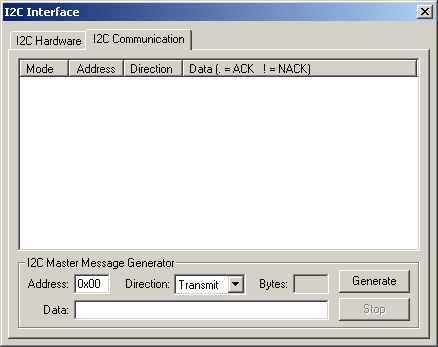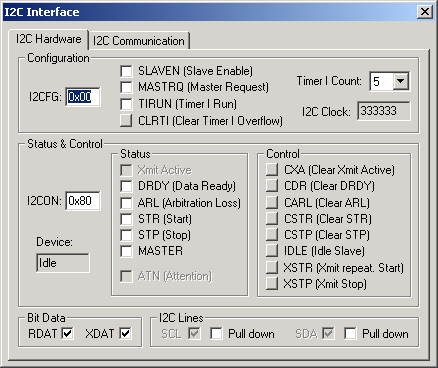|
||
| Products Download Events Support Videos | ||
Product Information
Device Database®
Downloads
Compliance Testing
Distributors
Peripheral Simulation
For NXP (founded by Philips) P89LPC9241 — I²C Interface
Simulation support for this peripheral or feature is comprised of:
- Dialog boxes which display and allow you to change peripheral configuration.
- VTREGs (Virtual Target Registers) which support I/O with the peripheral.
These simulation capabilities are described below.
I²C Interface Communication Dialog

The I²C Communication Dialog allows you to view the data sent or received on the I²C bus.
I²C Message Generator Group
- Address contains address of the sending or receiving device.
- Direction selects the direction of the message to be sent or received.
- Bytes is the length of the last message in bytes.
- Data is the message data sent or received.
- Generate starts message transmission.
- Stop suspends I²C bus communication.
To clear the message display, double-click anywhere in the message display area.
I²C Interface Hardware Dialog

The I²C Hardware Interface dialog displays all configuration options for the on-chip I²C controller. You may interactively alter and view these options using the dialog controls.
I2C_CLK VTREG
Data Type: unsigned long
The I2C_CLK VTREG specifies the clock frequency (in Hz) to use in SLAVE mode. For example:
I2C_CLK = 100000
specifies a clock frequency of 100KHz.
I2C_IN VTREG
Data Type: unsigned int
The I2C_IN VTREG contains data sent from an I²C peripheral to the simulated MCU. The following values may be written to this register:
- 0x0000-0x00FF: An address or data byte transfer.
- 0x0100: START byte. This initiates a SLAVE transmit or receive. The next byte sent is the address.
- 0xFF00: ACK.
- 0xFF01: NACK.
- 0xFFFF: IDLE or STOP condition.
I2C_OUT VTREG
Data Type: unsigned int
The I2C_OUT VTREG contains data sent from the simulated MCU to the I²C peripheral. The following values are possible:
- 0x0000-0x00FF: An address or data byte transfer.
- 0x0100: START byte. This initiates a MASTER transmit or receive. The next byte sent is the address.
- 0xFF00: ACK.
- 0xFF01: NACK.
- 0xFFFF: IDLE or STOP condition.
ProductsDevelopment Tools |
Hardware & Collateral |
Downloads |
Support |
Contact |
